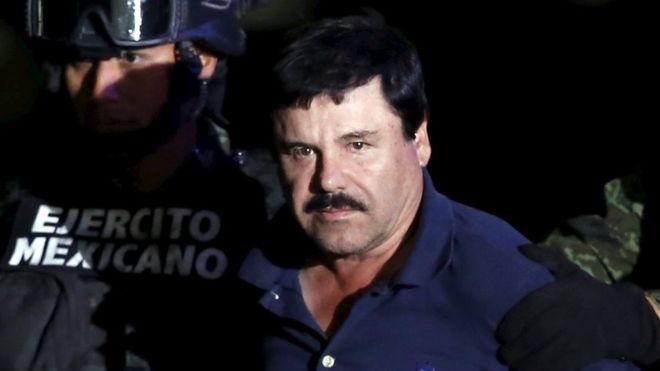Drug lord ‘El Chapo’ found guilty in US

Mexican drug kingpin Joaquín “El Chapo” Guzmán has been found guilty on all 10 counts at his drug trafficking trial at a federal court in New York.
Guzmán, 61, was arrested in January 2016 after escaping from prison through a tunnel five months earlier.
The Mexican was accused of being behind the all-powerful Sinaloa drug cartel, which prosecutors say was the biggest supplier of drugs to the US.
Key associates, including one former lieutenant, testified against him.
“El Chapo” (or “Shorty”) – once one of the world’s richest men – ran the cartel in northern Mexico.
Over time, it became one of the biggest traffickers of drugs to the US and, in 2009, Guzmán entered Forbes’ list of the world’s richest men at number 701, with an estimated worth of $1bn.
He was alleged to have helped export hundreds of tonnes of cocaine into the US, and was also accused of conspiring to manufacture and distribute heroin, methamphetamine and marijuana – and ordering killings.
The indictment said he employed hitmen to carry out “hundreds” of murders, assaults, kidnappings and acts of torture on rivals.
What did the court hear?
The trial provided shocking revelations about the Mexican drug lord’s life.
Court papers unsealed on Friday accuse him of having girls as young as 13 drugged before raping them.
Guzmán “called the youngest of the girls his ‘vitamins’ because he believed that sexual activity with young girls gave him ‘life'”, former associate Colombian drug trafficker Alex Cifuentes is quoted as saying.
During the trial Cifuentes also alleged that Guzmán gave a $100m (£77m) bribe to former Mexican President Enrique Peña Nieto, who is said to have contacted him after taking office in 2012 and asked for $250m in return for ending a manhunt for him. Mr Pena Nieto has not publicly commented.
Former bodyguard Isaias Valdez Rios said Guzmán beat two people who had joined a rival cartel until they were “completely like rag dolls”. He then shot them in the head and ordered their bodies be thrown on a fire.
In another incident, he had a member of the rival Arellano Felix cartel burned and imprisoned before taking him to a graveyard, shooting him and having him buried alive.
Guzmán is also alleged to have had his own cousin killed for lying about being out of town, and ordered a hit on the brother of another cartel leader because he did not shake his hand.
When asked by a former cartel lieutenant why he killed people, he is alleged to have said: “Either your mom’s going to cry or their mom’s going to cry.”
The court heard details of his 2015 escape from Mexico’s maximum-security Altiplano prison. His sons bought a property near the prison and a GPS watch smuggled into the prison gave diggers his exact location.
At one point Guzmán complained that he could hear the digging from his cell. He escaped by riding a specially adapted small motorcycle through the tunnel.
He also used spy software on his phone to spy on his wife and mistresses, which allowed the FBI to present his text messages in court.
In one set of texts, he recounted to his wife how he had fled a villa during a raid by US and Mexican officials, before asking her to bring him new clothes, shoes and black moustache dye.
Why was this trial significant?
Guzmán is the highest profile Mexican drug cartel boss so far to stand trial in the US.
The drug war in Mexico – pitting the Mexican and US authorities against cartels smuggling drugs into the US and the cartels against each other – has killed about 100,000 people over more than a decade.
Media captionA former DEA agent describes capturing Guzmán in 2014 – he later escaped
Guzmán achieved notoriety for twice escaping custody in Mexico as well as avoiding arrest on numerous other occasions.
Among some in his home state, he had the status of a folk hero, a popular subject of “narcocorridos” – musical tributes to drugs barons.
In 2016 he gave an interview to Hollywood actor Sean Penn in a Mexican jungle following his escape the previous year and boasted that he was the world’s leading supplier of heroin, methamphetamine, cocaine and marijuana.
He was later recaptured in the north-western town of Los Mochis. During the raid he fled through a drain but was later caught by troops in a shootout.
New York’s Brooklyn Bridge was closed each time the motorcade containing Guzmán drove across it
The US indictment against him is a consolidation of charges from six federal jurisdictions across the country, including New York, Chicago and Miami.
Prosecutors pooled together evidence acquired over more than a decade, including from international partners such as Mexico and Colombia, to build their sweeping case.
The trial jurors were anonymous and were escorted to and from the courthouse in Brooklyn by armed marshals after prosecutors argued that Guzmán had a history of intimidating witnesses and even ordering their murders.





